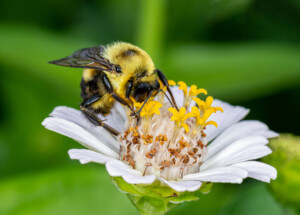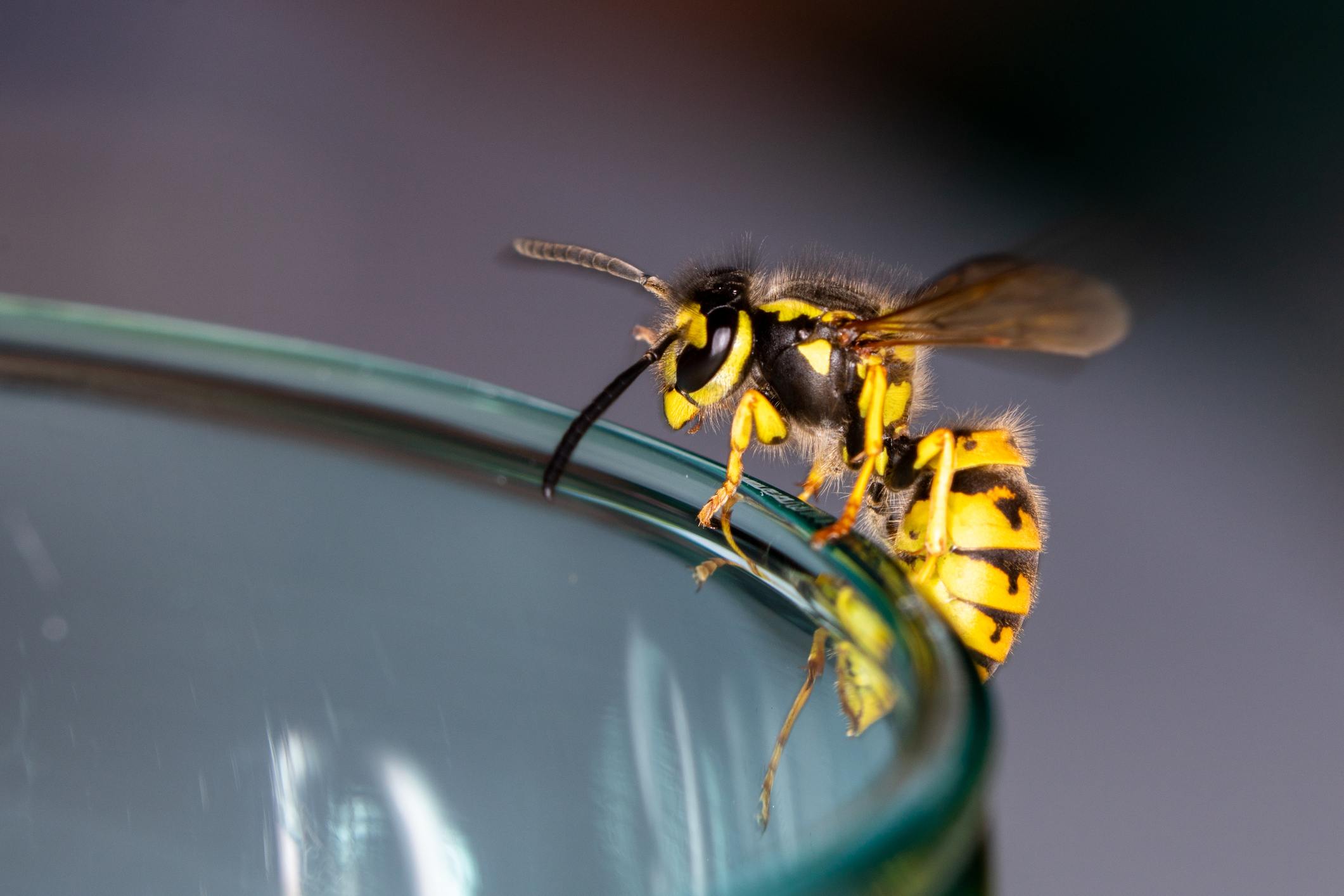Bumblebees are fascinating insects, vital to pollinating ecosystems in Wisconsin and across the world. While often confused with honey bees, bumblebees have their own unique traits, behavior patterns, and roles within nature. Whether you’re a nature enthusiast, gardener, or homeowner looking to protect your property from stinging insects, it’s important to learn about these bees to understand how to safely coexist with them or handle potential infestations.
BUMBLEBEES IN WISCONSIN
Wisconsin is home to a variety of bumblebee species, including the American bumblebee (Bombus pensylvanicus) and the rusty-patched bumblebee (Bombus affinis), which is listed as endangered. Bumblebees are one of the most efficient pollinators, playing a crucial role in the reproduction of many native plants and crops.
WHAT DO BUMBLEBEES LOOK LIKE?
Bumblebees, part of the Apidae family and genus Bombus, are larger and fuzzier than honey bees. They can range from 0.6 to 1 inch in length and are easily recognized by their black-and-yellow striped bodies, though some species may display other color variations, such as orange or red. Bumblebees are covered in thick, soft hair (setae) that gives them a fuzzy appearance, excellent for picking up pollen grains as they move from flower to flower.
The head features large compound eyes that aid in detecting movement and light, while the abdomen often has alternating bands of yellow, black, and sometimes orange or red. Like honey bees, female bumblebees have a corbicula on their hind legs used for collecting and transporting pollen.
SIGNS OF A BUMBLEBEE INFESTATION
Bumblebees typically prefer to nest in undisturbed areas, but they can sometimes settle in residential properties and in some cases, they may nest within wall cavities, attics or sheds. Signs of a bumblebee infestation include the presence of a nest, increased bee activity and frequently hearing a buzzing sound.
Things to look out for include frequent sightings of large, slow-moving bees around your yard, garden, or near the ground can indicate an established colony nearby. Bumblebees produce a distinct buzzing noise while flying. If you hear this sound near potential nesting sites like under decks or within wall spaces, it may signal a nest inside.
HABITAT, DIET, LIFE CYCLE & BEHAVIOURS
Bumblebees are fascinating insects due to their unique habits and vital role in nature. Let’s explore where they live, what they eat, their life cycle, and their key behaviors.
WHERE DO BUMBLEBEES LIVE?
Bumblebees are highly adaptive and can nest in a variety of locations. Unlike honey bees, which prefer permanent hives and nests, bumblebees typically nest underground, where they can establish their colonies in relative safety in places like abandoned rodent holes, or above ground in tall grass, compost heaps, or even under sheds. Some bumblebees may establish nests inside attics, wall cavities, or old bird nests.
DIET
Bumblebees rely on two primary sources of food: nectar and pollen. They collect nectar – their primary energy source – from flowers, using their long tongues to reach deep into blooms. While collecting nectar, bumblebees gather pollen grains on their hairy bodies. They store pollen in their corbicula to bring back to the nest, where it is mixed into “bee bread” to feed developing larvae.
Bumblebees are known to forage from a wide range of flowering plants, including wildflowers, crops, and garden plants, making them important pollinators in both agricultural and natural environments.
LIFE CYCLE
Bumblebees transition through four distinct life stages: egg, larva, pupa, and adult.
Egg: In early spring, a new queen bumblebee emerges from hibernation and establishes a nest. She lays her eggs in wax pots she constructs within the nest.
Larva: The eggs hatch into larvae, which are fed a mixture of nectar and pollen by the queen.
Pupa: After several weeks of feeding, the larvae spin cocoons and transition into pupae, where they will develop into adult bumblebees.
Adult: The first brood of worker bees emerges to help with foraging and colony maintenance, while the queen continues to lay more eggs.
As the colony grows throughout the summer, new queens and male drones are produced. At the end of the season, the colony dies off, with only the new queens hibernating through winter to start new colonies the following spring.
BEHAVIORS
Bumblebees are generally more docile than other stinging insects. However, they will sting if they perceive a threat to their nest, and, unlike honey bees, bumblebees do not die after stinging and can sting multiple times. They are active foragers, often traveling great distances from their nests in search of food. They will forage earlier in the morning and in cooler temperatures than honey bees.
Bumblebees are among the most efficient pollinators, particularly because of their ability to perform “buzz pollination.” In this process, they vibrate their bodies to release pollen from flowers, which is especially beneficial for crops like tomatoes.
ARE BUMBLEBEES DANGEROUS?
Bumblebees are generally not considered dangerous and are less aggressive than other stinging insects in Wisconsin, like wasps and hornets. However, they can pose a risk to individuals with allergies to bee stings. A bumblebee sting, while painful, is usually not life-threatening unless the individual has an allergy to bee venom. Unlike honey bees, which die after stinging, bumblebees have smooth stingers and can sting multiple times if provoked.
HOW TO GET RID OF BUMBLEBEES
If a bumblebee colony has established itself in or near your home, it’s crucial to handle the situation carefully to protect both yourself and the bees. Bumblebees are important pollinators, and their numbers are declining due to habitat loss and other factors.
Contact a professional pest control service: Never attempt to remove a bumblebee nest yourself, especially if it’s located in a hard-to-reach area or near areas of human activity. Professionals can assess the situation and safely remove or relocate the nest.
In some cases, a local beekeeper may be able to relocate the bumblebee colony to a safer environment where they can continue to pollinate without causing harm to humans.
HOW TO PREVENT BUMBLEBEES
Preventing bumblebees from nesting around your home is the best way to avoid potential conflicts with these insects. Here are some tips to reduce the likelihood of bumblebees nesting on your property:
Seal potential nest sites: Block entry points in sheds, garages, and attics, and ensure cracks in walls or foundations are sealed.
Limit ground cover: Bumblebees often nest in abandoned burrows, so reducing ground cover and keeping your yard clean of debris can deter them from nesting.
Manage flowering plants: Be mindful of planting flowering plants too close to high-traffic areas like patios or doorways. While it’s great to support pollinators, keeping blooming plants away from human activity can prevent attracting bumblebees to these areas.
By managing your landscape and sealing off potential nesting sites, you can reduce the likelihood of bumblebee infestations without harming these essential pollinators.
NEED HELP WITH STINGING INSECT CONTROL IN YOUR WISCONSIN HOME?
While bumblebees are essential for pollination, their nests in or around homes can pose risks. If you notice a bumblebee nest near your property and are unsure of how to handle it, it’s best to contact a residential pest control service for advice and safe removal. Stinging insect control specialists can help ensure that the bees are safely relocated, protecting both your home and these vital pollinators.
FAQS
DO BUMBLEBEES STING?
Yes, bumblebees sting when they feel their nest is threatened. Unlike honey bees, they do not die after stinging and can sting multiple times.
HOW LONG DO BUMBLEBEES LIVE?
Worker bumblebees typically live for about a month, while queens can live up to a year, depending on the species and environmental conditions.
ARE BUMBLEBEES AGGRESSIVE?
Bumblebees are generally not aggressive and will only sting in defense of their nest or if they feel threatened.
DO BUMBLEBEES DIE AFTER THEY STING?
No, unlike honey bees, bumblebees have smooth stingers and can sting multiple times without dying.
DO BUMBLEBEES HIBERNATE?
Only the new queens hibernate during the winter. The rest of the colony dies off at the end of the season, and the queens emerge in the spring to start new colonies.
Related Posts From Our Blog
How to Get Rid of Wasps in the Winter
Spotting a wasp around your home can be alarming, especially during the winter season. Running across a wasp can also be an indication of more in the area. Some wasps survive the colder months by [...]
When Wasps Attack: Signs of a Wasp Infestation and How to Prevent One
Wasps are among the most intimidating stinging insects to encounter. While many bees can only sting you once, wasps can sting multiple times. Stings are painful, and can even trigger an allergic reaction. When you [...]
Bite- and Sting-Free Celebrations
For many of us, the outdoors has become an escape from day-to-day life as we try to find a new normal with COVID-19. Warm weather combined with the need for social distancing also means that [...]
Bumblebee Facts & Identification in Sun Prairie, WI
Terminix Wil-Kil Pest Control is a local Pest Control and Extermination company helping homeowners and businesses with pest issues across WI.





